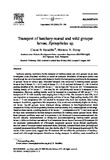Transport of hatchery-reared and wild grouper larvae, Epinephelus sp.

View/Open
Date
2003Page views
230Metadata
Show full item recordCited times in Scopus
85 readers on Mendeley
Share
Abstract
Optimum packing conditions for the transport of hatchery-reared and wild grouper larvae were investigated under simulated condition or actual air transport. Simulation of transport motion was done through the use of an electric orbit shaker to identify the best packing conditions for the transport of grouper larvae at various ages. Simulated transport was conducted in hatchery-reared grouper larvae at day 35 (mean TL=14.73 mm), 45 (mean TL=15.23 mm) and 60 (mean TL=28.16 mm) at packing densities of 50, 100 and 200 larvae l−1 and at high (28 °C) or low (23 °C) temperatures. Packing density of 50 larvae l−1 was best for 45- and 60-day-old larvae 8 h transport at low temperature. However, packing density could be increased to a maximum of 100 larvae l−1 8 h transport at 23 °C with mortality rates ranging from 2.3% to 5.3%. The increase in total NH3 level was dependent on temperature, packing density and size of larvae. High packing density (100–200 larvae l−1) and temperature (28 °C) resulted in increased NH3 level and mortality rates during transport. In addition, regardless of the temperature, NH3 levels were consistently higher for 60-day-old larvae. Day-60 grouper larvae displayed strong resistance to handling/mechanical stress compared to 35-day-old larvae probably because most are already fully metamorphosed at this stage. Based on these results, a packing density of 50 larvae l−1, a temperature of 23 °C and larval age of 60 days were considered as the best transport conditions for hatchery-reared grouper larvae. When these transport conditions were used in experiment 2, for 26-day-old hormone-metamorphosed, 60-day-old naturally metamorphosed or 60-day-old pre-metamorphosing hatchery-reared grouper larvae, a 100% survival rate was attained in all treatments. Seven days of hormone (T3) treatment did not accelerate metamorphosis of wild-caught transparent grouper larvae (tinies) significantly. Survival rates of hormone-treated transparent tinies (H-tinies), untreated black tinies (B-tinies) and untreated transparent tinies (T-tinies) were also similar after 8–9 h air transport (experiment 3). The results of the current study suggest that T3 treatment did not affect the performance of hatchery-reared and wild-caught transparent tinies/larvae during transport. In addition, mass mortalities of these transported tinies during the nursery phase were associated with nutritional aspect and the sudden confinement of these undomesticated wild-caught grouper to small space rather than transport or hormone treatment effects.
Suggested Citation
Estudillo, C. B., & Duray, M. N. (2003). Transport of hatchery-reared and wild grouper larvae, Epinephelus sp. Aquaculture , 219(1-4), 279-290. https://doi.org/10.1016/S0044-8486(02)00413-1
Subject
Collections
- AQD Journal Articles [1248]

